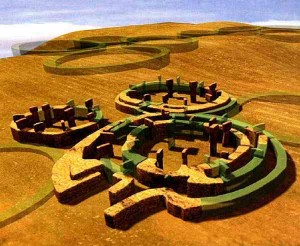from Cosmic World
 I don’t know much about prehistoric symbols but I love to learn as much as I can about them. So it is with some fascination that I read an article about the mysterious and perhaps the Deliberate Burial of Three Ancient Megalithic Stone Circles .
I don’t know much about prehistoric symbols but I love to learn as much as I can about them. So it is with some fascination that I read an article about the mysterious and perhaps the Deliberate Burial of Three Ancient Megalithic Stone Circles .
Three Stone Circles at Göbekli Tepe were discovered in southern Turkey. These stone circles were deliberately buried thousands of years ago on a hilltop were located at Göbekli Tepe. The interesting thing is that these circles are several thousand years older than the first stone circle built at Stonehenge, and they were built by a hunter-gatherer society.
We are still deciphering the mystery of how Stonehenge was built and what it was used for and now we have something even older to contemplate. I am not sure why scientists say that they were deliberatly buried – certainly after thousands of years rocks and artifices are naturally buried. But the far more interesting theory here is that these stones and the surrounding area is actually the Garden of Eden. The article (which is linked to above) says:
Ideas that Göbekli Tepe and the surrounding region is the historical reality behind the biblical Garden of Eden may not be as far fetched as they first seem. Archeology in Syria and Turkey has established that the region later known as the ‘fertile crescent’ was very lush immediately after the last Ice Age ended. The environment was exceptionally rich, herds of wild animals were huge, and plants and food were easily obtained. Gazelle herds might number 100,000, and permanent settlements were erected by 12,000 B.C. by nomadic hunters to store dried meat.
English archeoastronomy researcher Andrew Collins identifies Eden as a large region encompassing Upper Mesopotamia (Southeast Turkey, Northern Syria and Northern Iraq). He believes that the Biblical Garden of Eden in the Old Testament is a transformed memory that persisted throughout the ancient cultures of Mesopotamia. This memory of the extremely lush environment of this region of the fertile crescent immediately after the Upper Paleolithic ended and the glaciers retreated north may have been deliberately and carefully preserved by the priesthoods of Sumer, Egypt, Bablyon and Assyria. This ‘legend’ became the Garden of Eden in the Christian Old Testament.
I have read that the stories of the Bible are based on actual events that, through the oral history, morphed in the recounting of these stories but that at its heart, the Bible is a historical book. So I am not surprised that we might have discovered the basis of the Garden of Eden. If all was surrounded by Ice Age remnents, a fertile crescent might have seemed Eden-like. What might be equally interesting is what the rest of the world looked like at the time as a comparison to this Eden.
